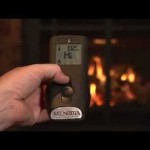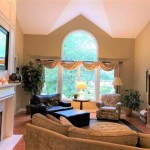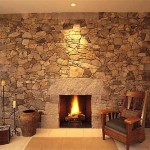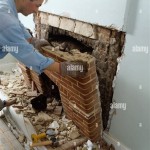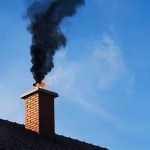Remodel Old Fireplace: New Design Possibilities
An outdated fireplace can significantly detract from the overall aesthetic of a living space. Remodeling an old fireplace presents an opportunity to revitalize the room, enhance its functionality, and increase its value. This article explores the various aspects of fireplace remodeling, focusing on design considerations and practical implementation.
The decision to remodel a fireplace often stems from a desire to update its appearance, improve its energy efficiency, or address structural issues. Before embarking on a remodeling project, a thorough assessment of the existing fireplace is crucial. This includes inspecting the firebox, chimney flue, hearth, and surrounding mantle. Identifying any structural damage, such as cracks or crumbling mortar, is paramount for safety and longevity.
Budget considerations play a significant role in determining the scope of the remodel. A simple cosmetic update, such as painting the existing brick or replacing the mantle, will be significantly less expensive than a complete overhaul involving structural modifications or changes to the fireplace's fuel source. Establishing a realistic budget early in the process helps to narrow down the design options and prevent cost overruns.
Assessing the Existing Fireplace Structure
A comprehensive assessment of the existing fireplace structure is the foundational step in any remodeling project. This process involves a detailed examination of various components to identify potential issues and inform design decisions. The following elements should be carefully evaluated:
Firebox Inspection: The firebox, the chamber where the fire burns, should be inspected for cracks, spalling (surface deterioration), and any signs of damage from excessive heat or moisture. A damaged firebox can compromise the safety of the fireplace and may require repair or replacement. Minor cracks can often be repaired with refractory mortar, while more extensive damage may necessitate relining the firebox with firebricks or installing a complete firebox insert.
Chimney Flue Evaluation: The chimney flue, the passage through which combustion gases are vented, is critical for safe operation. A professional chimney sweep should inspect the flue for obstructions, such as bird nests or debris, and for any signs of deterioration, such as cracks or missing mortar. Creosote buildup should also be assessed, as excessive creosote can pose a fire hazard. Depending on the condition of the flue, cleaning, repair, or relining may be necessary. Relining typically involves inserting a new stainless steel or ceramic flue liner into the existing chimney.
Hearth Evaluation: The hearth, the non-combustible area in front of the fireplace opening, serves as a safety barrier to prevent sparks and embers from igniting surrounding materials. The hearth should be inspected for cracks, chips, and any signs of damage. If the hearth is damaged or outdated, it can be replaced with new materials such as tile, stone, or brick. The size and thickness of the hearth should comply with local building codes to ensure adequate fire safety.
Mantle and Surround Examination: The mantle and surround are the decorative elements surrounding the fireplace opening. The condition of these elements should be assessed to determine if they need repair, replacement, or refinishing. The mantle should be securely attached to the wall and free from any structural defects. The surround, which can be made of various materials such as brick, stone, or wood, should be inspected for cracks, stains, and other signs of wear. If desired, the mantle and surround can be completely replaced to create a new focal point in the room.
This initial assessment provides a clear understanding of the fireplace's condition and informs the subsequent design and remodeling decisions. Addressing any structural issues before proceeding with cosmetic updates is crucial for ensuring the safety and longevity of the remodeled fireplace.
Design Considerations for a Fireplace Remodel
The design phase of a fireplace remodel is crucial for creating a visually appealing and functional focal point. Several factors should be considered when selecting a new design, including the overall style of the room, the desired aesthetic, and the functional requirements of the fireplace. Some popular design styles include:
Modern Fireplaces: Modern fireplace designs often feature clean lines, minimalist aesthetics, and contemporary materials such as concrete, glass, and stainless steel. These fireplaces may incorporate linear fireboxes, floating mantles, and integrated storage solutions. A modern fireplace can enhance the contemporary feel of a room and create a sleek and sophisticated ambiance.
Traditional Fireplaces: Traditional fireplaces typically feature classic designs with ornate details, such as carved mantles, raised hearths, and brick or stone surrounds. These fireplaces often incorporate elements of historical architectural styles, such as Georgian, Victorian, or Federal. A traditional fireplace can add warmth and character to a room and create a timeless and elegant atmosphere.
Rustic Fireplaces: Rustic fireplace designs often incorporate natural materials such as reclaimed wood, river rock, and rough-hewn beams. These fireplaces may feature large, open fireboxes and rugged, textured surfaces. A rustic fireplace can create a cozy and inviting atmosphere and evoke a sense of warmth and authenticity.
Transitional Fireplaces: Transitional fireplace designs blend elements of both modern and traditional styles, creating a balanced and versatile aesthetic. These fireplaces may feature clean lines and simple shapes, combined with classic materials and details. A transitional fireplace can complement a wide range of interior design styles and create a timeless and sophisticated look.
In addition to selecting a design style, consider the materials used for the fireplace surround, mantle, and hearth. Common materials include brick, stone, tile, wood, and concrete. Each material offers different aesthetic properties and performance characteristics. For example, stone provides a natural and durable finish, while tile offers a wide range of colors and patterns. The choice of materials should complement the overall design style and the existing décor of the room.
Furthermore, consider the fuel source for the fireplace. Options include wood-burning, gas-burning, and electric fireplaces. Wood-burning fireplaces offer the traditional ambiance of a real fire but require more maintenance and produce more emissions. Gas-burning fireplaces are more convenient and cleaner-burning, but they require a gas line connection. Electric fireplaces are the easiest to install and operate, but they lack the authenticity of a real flame.
By carefully considering these design factors, you can create a fireplace that not only enhances the aesthetic appeal of your home but also provides warmth, comfort, and enjoyment for years to come.
Practical Implementation of the Fireplace Remodel
Once the design has been finalized and the necessary materials have been selected, the practical implementation of the fireplace remodel can begin. This phase involves removing the existing fireplace components, preparing the area, and installing the new elements. The specific steps involved will vary depending on the scope of the remodel and the design chosen.
Demolition and Removal: The first step typically involves demolishing and removing the existing fireplace surround, mantle, and hearth. This may require the use of tools such as a sledgehammer, chisel, and pry bar. Care should be taken to protect the surrounding walls and flooring from damage. Dispose of the debris responsibly and in accordance with local regulations.
Structural Modifications: If the remodel involves structural modifications, such as enlarging the firebox or altering the chimney, a qualified contractor should be hired to ensure that the work is performed safely and in compliance with building codes. These modifications may require obtaining permits from the local building department.
Installation of New Components: Once the area has been prepared, the new fireplace components can be installed. This may involve installing a new firebox, chimney liner, hearth, surround, and mantle. Follow the manufacturer's instructions for installation and ensure that all connections are properly sealed and secured. If installing a gas-burning fireplace, a qualified gas technician should be hired to connect the gas line and ensure that the system is operating safely.
Finishing Touches: After the main components have been installed, the finishing touches can be applied. This may involve painting or staining the surround, adding decorative trim, and installing accessories such as a fireplace screen or tool set. These details can help to customize the fireplace and create a polished and professional look.
Safety Inspection: Before using the remodeled fireplace, it is essential to have it inspected by a qualified professional. This inspection will ensure that the fireplace is operating safely and that all components are properly installed. The inspector will check for any leaks, obstructions, or other potential hazards. Once the fireplace has passed inspection, it can be used and enjoyed with confidence.
Remodeling a fireplace requires careful planning, attention to detail, and adherence to safety guidelines. By following these steps, homeowners can transform an outdated fireplace into a beautiful and functional focal point that enhances the value and enjoyment of their home.
Ultimately, a successful fireplace remodel hinges on clear communication between the homeowner and any contractors involved. Maintaining an open dialogue throughout the process, addressing any concerns promptly, and conducting regular site visits ensures that the project stays on track and the final result meets expectations.

Fireplace Remodel Kristen Rinn Design

10 Fireplace Makeover Ideas Before And After Regency

47 Stellar Diy Fireplace Remodel Makeover Ideas Remodelaholic

30 Fireplace Remodel Ideas For Any Budget
5 Great Ways To Remodel An Old Fireplace
5 Amazing Inexpensive Easy Fireplace Remodel Transformations Designed

83 Fireplace Remodels Ideas Remodel Home

47 Amazing Fireplace Remodel Ideas To Diy Artsy Pretty Plants

30 Fireplace Remodel Ideas For Any Budget

Fireplace Remodel Design Gas Makeover
Related Posts

